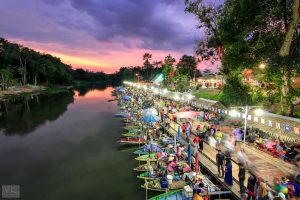Thailand is one of the most popular travel destinations in the world. Thailand is a Southeast Asian country. The vast majority of Hat Yai’s tourists gravitate toward its night markets and street foods that sprawl all over the country’s southern pearl. However, explore beyond the hustle and bustle of this metropolis in southern Thailand and you’re in a different domain, a land of idyllic beaches and a massive seven-story-high waterfall. There is something that sets Hat Yai apart from others (like Bangkok), but it’s truly something that cannot be explained, only felt.
Know About Hat Yai, Thailand
Hat Yai (หาดใหญ่; also Hatyai, Had Yai, Haad Yai) is the fourth largest city in Thailand, the largest city in southern Thailand, and is in Songkhla Province on the Southern Gulf Coast. It’s a popular tourist spot for Malaysians, Singaporeans, Indonesians on holiday, and for Thais from neighbouring provinces. It’s best avoided if you are looking to get off the beaten path. Prices are relatively high in tourist areas. This place has comparatively few Western visitors. The city can be a stop for tourists on a journey to Southern Thailand’s beaches and islands, or further down south to Malaysia and Singapore.
Now, Hat Yai is the biggest megacity in Southern Thailand. The population is around in the megacity and roughly in the whole Hat Yai District. Chapeau Yai is bigger than the parochial capital of Mueang Songkhla, which is unusual for a Thai fiefdom. This means that Hat Yai is frequently incorrect as the capital of Songkhla fiefdom. It’s 60 km from the Thailand-Malaysia border at Dannok and Padang Besar in the Sadao quarter. Chapeau Yai has come a centre for business, education, transportation, tourism, and shopping in south Thailand due to the well-established connections by road, rail, and air. The megacity has been a melange of Thai, Chinese, and Malay for generations. Trading, manufacturing, and tourism contribute much to its frugality.
Southern Thai shoptalk is prominent, although Central Thai is used in services and seminaries. Numerous Thai Chinese of aged generations can speak a Chinese shoptalk called Teochew. English is spoken by some young people.
Know Hat Yai Restaurants & Dining
The fish maw soup here is rich and thick, yet not overpowering. Coupled with some bamboo shoots, gormandizer’s blood and quail eggs, this is simply perfect. Add some ginger for redundant oomph. Each coliseum of fish gullet haze costs THB 150. Still, you need to visit Thanatsri Hat Yai for breakfast, If you’re looking for the stylish beef ball polls haze. Chapeau Yai is quite a savorer haven, isn’t it? If you’re thinking of a short caper, you might want to consider this beautiful city. Regarding Asian food, Thai, Chinese, Malay and Indian cookeries are veritably well represented in Hat Yai with venues similar as Kan Eng Restaurant (Thai), Chokdee Dim Sum (Chinese), Namaste Hatyai (Indian) and Serai Restaurant (Malay, Halal).
Before leaving Hat Yai you must go to Phang Nga Restaurant
Thai food carefully blends elements from traditional Southeast Asian cuisine to achieve a complex yet balanced flavour, combining sweet, sour, bitter and salty tastes. Thailand food also has unique regional dishes that correspond to the northern, northeastern, central and southern areas of the country.




